Wet conditions leave farmers out to dry
June 6, 2013
Iowa is a state synonymous with the combines and farmers that till the rich soil and plant crops that stretch deep into the horizon, as far as the eye can see.
Agriculture is Iowa’s backbone. Thousands of sprawling acres reach across the land to keep the state thriving.
With a heavy dependency on agriculture, favorable weather is crucial. However, recent fluctuations in the weather have kept many farmers out of their fields.
According to a Department of Natural Resources Water Summary Update, published May 30, 2013, the statewide average precipitation of 16.65 inches during the spring season — March, April and May — is the highest total ever seen in 141 years of record keeping.
The wet conditions have also delayed many farmers from planting their crops when they need to.
The Iowa Department of Agriculture’s Crop and Weather Report, released on Monday, June 3, 2013, lists the amount of corn planted at 88 percent, which is lower than the five-year average of 99 percent for this time of the year. The planting of soy beans for this time of year has also dropped significantly. Only 44 percent of Iowa’s soy beans have been planted, which is well below last years average of 99 percent and the five-year average of 91 percent.
With much of the state under flood watches or warnings during the past weeks, professor Brian Hornbuckle said it’s the wet conditions that should be the agricultural concern.
“Flooding is not really an issue. The wet soil conditions delay planting, which means now you’re pushing the end of the year because when the frost comes, that kills all the plants, and at the end of the year is when you accumulate the grain and the starch,” Hornbuckle said. “So, if we have an early frost, that could be a big problem if things have been planted late.”
Brian Chambers owns and operates a 500-acre farm in Marble Rock. Chambers was lucky enough to have already planted his corn, but says getting enough time to work in the fields is still a problem.
“The biggest thing with the wet weather is that we haven’t had very many days to do our field work and, of course, it takes a certain number of days, irregardless of the size of our machinery, to cover the ground,” Chambers said. “The lack of sunshine also cuts down on photosynthesis, so the crops aren’t as healthy as they should be and that can lead to other diseases.”
Extreme contrast
Iowans will remember last year when the state was hit with one of its worst droughts tin recent years. Last year’s drought is chiefly different from this year’s wet conditions, but professor Elwynn Taylor explains that the swift shift in weather extremes holds the same result for crop yield.
“Our crops aren’t adapted to big shifts,” Taylor said. “So, when we get extremes one way, that’s not good, when we get extremes the other way, that isn’t good either, but extremes both ways is almost twice as bad.”
However, Chambers is optimistic the crops will fare better in this year’s wet conditions than they did is last year’s dry conditions.
“The crops will produce with the moisture, even with excessive moisture, it will hurt it some, but it wont be like a drought,” Chambers said. “Last year, we were in a very bad area where there were a couple of farms that were in that 20 to 30 bushel of corn per acre range, and there was nothing you could do.”
Taylor says that the juxtaposition of a record drought and a record wet spring is not something new to Iowa.
“Our worst droughts are the ones that had a wet spring,” Taylor said. “In 1936, we had the wettest winter of the century, as well as the driest, hottest summer of the century. This also happened in 1947, 1956, 1977, 1983, 2002, and this year.”
Repeating History
Aside from the transition from dry to wet conditions, Taylor has also found something else that links current conditions to the past.
“So far, this year has been a carbon copy of 1947,” Taylor said. “1947 followed a fairly dry year, but not a drought. In 1947, we had a record snow in May that was not broken until this year. 1947 also saw record floods in western Iowa during May and that was broken this year.
“We had a 100-degree day shortly after we had snowfall. There were great temperature variations in 1947 as well.”
1947 was also one of the five worst years for crop yields in state history, according to Taylor.
“We had such a wet, cold spring that not all of the crops were planted in a timely manner and the ones that were planted had such an excess of water that they didn’t develop great roots,” Taylor said. “The rain quit the first of July and didn’t start again until early September. The temperature also went above normal around July 15 and stayed above normal until September.”
Because of the wet and cold planting conditions, the crops had poor roots and couldn’t handle the hot, dry summer, Taylor says.
“There’s potential of that happening again this year,” Taylor said. “For eight months, we’ve tracked right along like 1947. It only takes four more months and we’ve got the whole year.”
Keeping things dry
Farmers cannot prevent rain from falling and producing too wet of conditions, but measures can be taken to reduce its impact.
“One of our biggest ways [of decreasing wet conditions] is reducing tillage,” Chambers said. “Minimum tillage leaves more residue on the surface, which helps hold the soil in place.”
Chambers has also seen a resurgence in grass waterways and tiles as a benefit in keeping water from saturating the fields.
In a time when the weather is keeping many farmers from their fields and doing their jobs, Chambers is thankful for getting his crops into the ground.
“We had all corn and we got everything planted. We got that done but we haven’t got much else done,” Chambers said. “We’ve been one of the fortunate ones.”






